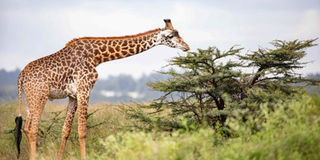Prime
New findings confirm four distinct giraffe species

Giraffes in Kidepo Valley National Park. Over the years, giraffes have been thought to have only a specie. PHOTO/XINHUA
What you need to know:
- Giraffe are assumed to have similar ecological requirements across their range.
Until recently, giraffe were widely recognised as a single specie with several sub-species, but new findings now indicate there are four distinct giraffe species.
The findings, reported on May 5, 2021, in the peer-reviewed scientific journal, Current Biology, make a strong case for recognising the four giraffe species. The report says this would be a major step in protecting each species, some of which are under great threat in the wild.
The researchers, who authored the study, point out that a consensus on the number of giraffe species was paramount in correctly assessing their individual conservation status and afford each species adequate protection based on their level of threat on the International Union for Conservation of Nature (IUCN) Red List.
The latest estimates by the Giraffe Conservation Foundation (GCF) show there are only 117,000 giraffes surviving in Africa. This leaves only one giraffe for every four African elephant in the wild. Giraffe numbers have dropped by almost 30 per cent over the last three decades as a result of habitat loss and fragmentation, poaching, disease, civil war and climate change.
“However, it is important to note that numbers vary greatly between the four species as does the level of threat they face. Some giraffe species are in serious trouble while others are doing relatively well,” GCF adds in a statement.
The research group has collaboratively analysed giraffe genetics for more than a decade; initially, to find out how similar or dissimilar giraffe in Africa were to each other.
“To put our results into perspective, the genetic differences between the distinct giraffe species are similar to those between polar and brown bears,” says Dr Axel Janke, a geneticist at the Senckenberg Biodiversity and Climate Research Centre and Goethe University in Germany.
In the new study, the collaborative research team which included other experts from the Smithsonian Conservation Biology Institute, Chinese Academy of Sciences and ITMO University, examined evidence taken from skin biopsies of a subset of more than 1,000 giraffe collected by the GCF and its partners throughout Africa over the last two decades.
The extensive sampling includes populations from all nine previously recognised giraffe subspecies, including remote locations and areas of civil unrest.
The new analysis confirms four highly distinct groups of giraffe, which seemingly do not mate with each other in the wild. The four species include the Maasai giraffe, the northern giraffe, the reticulated giraffe, and the southern giraffe.
Both southern and northern giraffe have two and three distinct subspecies, namely Angolan and South African giraffe for southern giraffe, and Kordofan, Nubian, and West African giraffe for northern giraffe. It is likely that Zambia’s Luangwa giraffe is a subspecies of the Maasai giraffe. A more detailed analysis is still required along with other Maasai giraffe across their range in East Africa.
The researchers stress that the results have significant conservation implications, noting that similar to the recent IUCN Red List announcement of two species of African elephant, it is important that giraffe get assessed separately for each species.
Giraffe as one species are currently listed as vulnerable on the IUCN Red List, but separate assessments of each species would likely show three of the four species as endangered or critically endangered.
The director of GCF, Dr Julian Fennessy, says: “We estimate that there are less than 6,000 northern giraffe remaining in the wild. Their numbers have declined by more than 90 per cent in the last 35 years. As a species, they are one of the most threatened large mammals in the world and we need to urgently increase our protection efforts of this species before it is too late. The conservation implications of this genetic research are immense, and it would be ignorant to ignore these new findings. It’s time to act now!”
“Giraffe are assumed to have similar ecological requirements across their range,” he added, “but no one really knows, because this megafauna has been largely overlooked by science. More conservation research is urgently needed to help us understand more about giraffe ecology across their range.”




